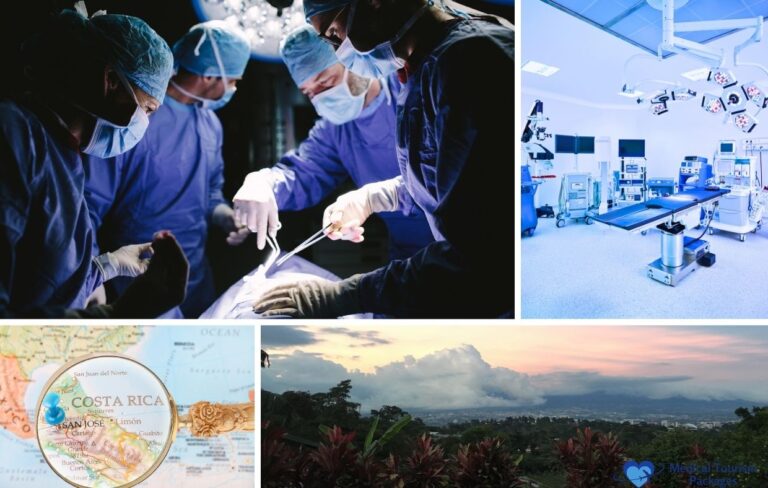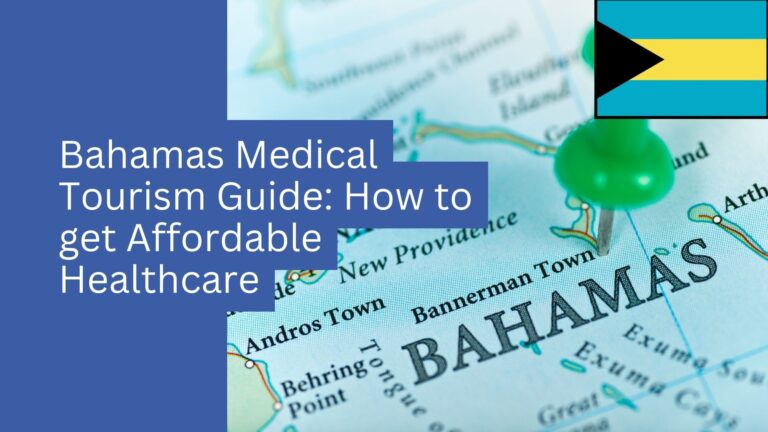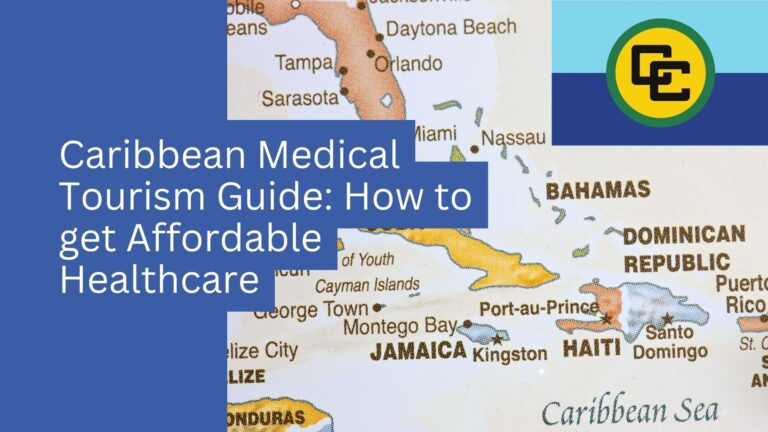Book Appointment Now
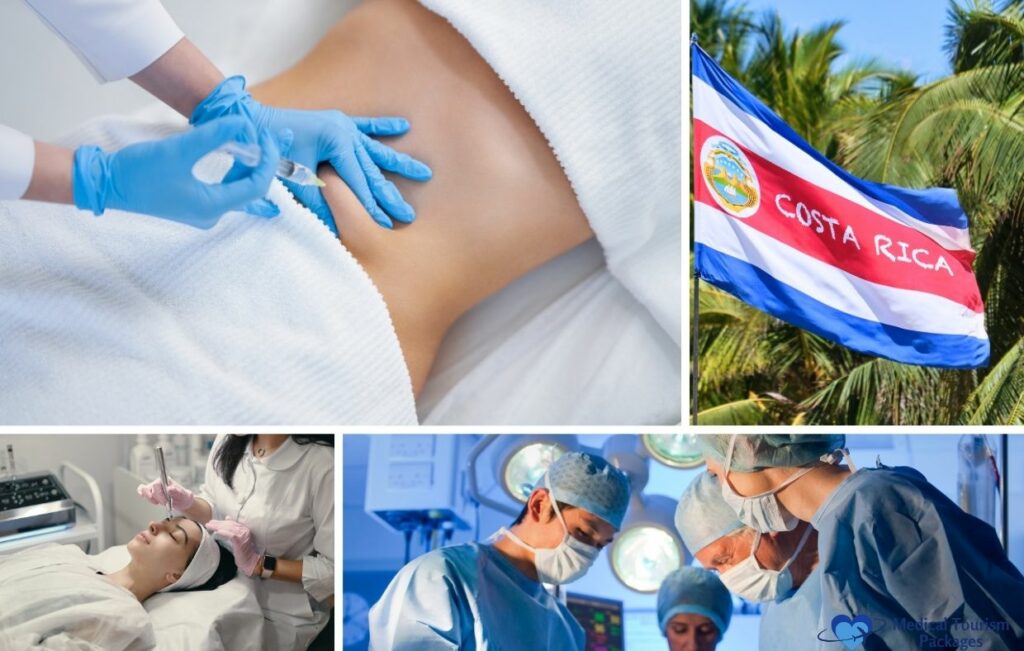
Liposuction in Costa Rica: Complete Cost Guide and Procedure Information
Costa Rica attracts thousands of medical tourists each year for liposuction procedures. Patients can save 40-60% compared to US prices while receiving care from internationally trained surgeons in JCI-accredited facilities.
Liposuction targets stubborn fat deposits in areas like the abdomen, thighs, arms, and flanks that resist diet and exercise. The procedure sculpts body contours rather than serving as a weight loss solution, making it ideal for patients already near their goal weight.
This guide breaks down current liposuction costs in Costa Rica and explains what influences pricing. You’ll learn how to evaluate surgeons, understand different techniques, and plan your medical travel logistics. We also cover recovery timelines and safety considerations to help you make an informed decision.
What is Liposuction and Why Choose Costa Rica?
Liposuction is a surgical procedure that removes excess fat deposits through suction using thin tubes called cannulas. Surgeons insert these cannulas through small incisions and break up fat cells before vacuuming them out. The technique targets stubborn fat resistant to diet and exercise in areas like the abdomen, thighs, hips, arms, and neck. Liposuction reshapes body contours rather than serving as a weight loss solution, which means ideal candidates are already near their target weight.
Costa Rica offers compelling advantages for medical tourists seeking liposuction. Patients save 50-70% compared to US prices while maintaining high medical standards. The country uses the US dollar as its official currency, which eliminates exchange rate risk when budgeting for your procedure. Direct flights from major North American cities take just three to five hours, making travel convenient for pre-operative consultations and follow-up care.
The country’s modern healthcare infrastructure rivals what you’ll find in developed nations. Many Costa Rican plastic surgeons completed training in the United States or Europe and maintain certifications from international boards. Beyond the economic benefits, Costa Rica provides political stability and a safe environment for recovery. Patients often combine their medical trip with recuperation at beach resorts or mountain retreats, turning necessary recovery time into a therapeutic experience.
How Much Does Liposuction Cost in Costa Rica?
Liposuction in Costa Rica costs significantly less than in North America while maintaining comparable quality standards. The table below shows how Costa Rican prices compare to other popular destinations.
How Does Costa Rica Compare to Other Countries for Liposuction Costs?
| Country | Price Range | Savings vs US |
|---|---|---|
| Costa Rica | $1,500 – $7,500 | 40-70% |
| United States | $4,711 – $12,000+ | N/A |
| Colombia | $2,000 – $8,000 | 35-65% |
| Mexico | $1,800 – $6,900 | 40-68% |
| Panama | $2,000 – $7,000 | 40-65% |
Several factors influence the final cost of your liposuction procedure:
- Number of body areas treated: Single body areas cost less than treating multiple zones in one session
- Complexity of procedure: Larger treatment areas or fibrous fat deposits require more time and expertise, which increases the price
- Surgeon’s expertise and experience level: Board-certified surgeons with extensive training and international certifications typically charge higher fees than less experienced practitioners
Who is a Good Candidate for Liposuction in Costa Rica?
Good candidates for liposuction are adults in good overall health who fall within 30% of their ideal body weight. The procedure works best for patients with localized fat deposits that resist diet and exercise in specific areas like the abdomen, flanks, or thighs. Candidates must have realistic expectations about body contouring rather than viewing liposuction as a weight loss solution. Surgeons also assess skin elasticity since good skin tone helps achieve smooth, natural-looking results after fat removal.
Costa Rican clinics conduct comprehensive medical screenings before approving patients for surgery. These evaluations include your complete medical history, current medications, and any chronic conditions you manage. The screening process protects your safety and helps surgeons determine whether liposuction presents acceptable risks for your specific health profile.
What Medical Requirements and Health Conditions Affect Candidacy?
Certain medical conditions may disqualify you from surgery or require additional evaluation before your surgeon can approve the procedure.
| Condition | Risk Level | Candidacy Status |
|---|---|---|
| Heart disease/hypertension | High | Disqualified |
| Blood clotting disorders | High | Disqualified |
| Well-controlled diabetes | Moderate | May qualify |
| Unmanaged diabetes | High | Disqualified |
| Pregnancy/breastfeeding | High | Wait 6+ months |
| Active infections | High | Must resolve |
| Smoking | Moderate | Quit 4+ weeks before |
| Age under 18 | Moderate | Requires maturity assessment |
Which Body Areas Can Be Treated with Liposuction?
Liposuction can address fat deposits in multiple body areas during a single procedure. Surgeons follow international safety guidelines that limit fat removal to five liters per session to minimize surgical risks.
Upper Body Areas:
- Arms (reduces fat in upper arms and tricep area)
- Back (treats bra bulge and lower back rolls)
- Chest (addresses male gynecomastia and excess tissue)
- Neck (removes submental fat under the chin)
Lower Body Areas:
- Abdomen (targets upper and lower belly fat)
- Flanks (eliminates love handles on the sides)
- Hips (contours outer hip bulges)
- Buttocks (reshapes and lifts the buttock area)
- Thighs (treats inner, outer, and front thigh fat)
Specialized Areas:
- Calves and ankles (require advanced precision techniques)
- Face (demands specialized training for delicate contouring)
What Types of Liposuction Techniques are Available in Costa Rica?
Costa Rican clinics offer multiple liposuction techniques to match different patient needs and body areas. Each method uses distinct technology to remove fat and achieve specific aesthetic goals.
How Do Different Liposuction Techniques Compare?
| Technique | How It Works | Key Benefits | Cost Range | Best For |
|---|---|---|---|---|
| Traditional Tumescent | Fluid infiltration into fat tissue | Proven effectiveness, reduced bleeding, lower cost | $1,500-$4,000 | Large-volume removal, all body areas |
| VASER/Ultrasound | 36,000 Hz sound waves break up fat | 53% less blood loss, 26% better skin retraction | $3,500-$6,500 | Fibrous areas, athletic definition |
| Laser-Assisted | Laser energy liquefies fat cells | Skin tightening effect, minimal incisions | $1,500-$3,000 | Small precise areas like neck and arms |
| Power-Assisted (PAL) | Vibrating cannula at 2,000-4,000 cycles/min | 30% faster procedure, gentler on tissue | Similar to traditional | Large volumes, revision procedures |
| Lipo 360 | Comprehensive midsection treatment | Complete 360-degree waist contouring | $4,500-$7,500 | Full midsection transformation |
Where are the Best Liposuction Clinics in Costa Rica?
JCI-accredited hospitals meet rigorous international standards for patient safety, infection control, and quality of care. Choosing an accredited facility over non-accredited centers significantly reduces your surgical risks and ensures consistent protocols throughout your treatment. These hospitals undergo regular audits and maintain the same safety benchmarks required in North American medical centers.
What Are the Top-Rated Medical Centers in Costa Rica?
- CIMA San José: JCI-accredited with Johns Hopkins Medicine International affiliation
- Clínica Bíblica: JCI-accredited facility with over 90 years of healthcare experience
- Hospital la Católica: JCI-accredited hospital serving the greater San José area
- Centro Médico Paitilla: Maintains national certification standards
How Do You Verify Surgeon Credentials?
Before selecting your surgeon, verify these essential qualifications:
- Board certification: Confirm certification in plastic surgery from recognized medical boards
- Active licensing: Verify current registration with the Costa Rican College of Doctors and Surgeons
- Training credentials: Look for residency or fellowship training from prestigious institutions like Cornell or Baylor
- Hospital privileges: Ensure your surgeon operates at internationally accredited hospitals
- Professional memberships: Check for ISAPS or ASPS membership
What Are the Main Steps to Getting Liposuction in Costa Rica?
The process of getting liposuction in Costa Rica follows a structured timeline from initial research to final results. Understanding each phase helps you plan your medical trip effectively.
- Choosing a Qualified Surgeon – Research board-certified surgeons who specialize in liposuction. Verify credentials through ISAPS or the Costa Rican College of Doctors and Surgeons. Check that your surgeon maintains hospital privileges at accredited facilities.
- Initial Consultation – Schedule a consultation to discuss your aesthetic goals, medical history, and treatment options. Many clinics offer virtual consultations for international patients. Your surgeon will evaluate your candidacy and provide a personalized quote.
- Surgery Preparation – Follow all pre-operative guidelines provided by your surgical team. Arrange your travel logistics including flights and accommodation. Complete required medical clearances and lab tests before your procedure date.
- Surgery Day – Your surgery day begins with pre-operative preparation and an anesthesia consultation. The surgeon marks your treatment areas before the procedure. Liposuction typically takes one to four hours depending on the number of areas treated.
- Initial Recovery – You’ll recover in a monitored setting immediately after surgery. Wear compression garments as directed and follow activity restrictions. Initial results become visible within two to three weeks as swelling decreases.
- Final Results – Complete results appear three to six months after surgery once all swelling resolves. Your body contours continue improving as tissues settle into their new shape.
How Long Should You Stay in Costa Rica After Liposuction?
Your recovery timeline determines how long you should remain in Costa Rica after liposuction. The complexity of your procedure affects both your minimum stay and when you can safely fly home.
| Procedure Complexity | Minimum Stay | Flight Clearance | Symptoms/Activity |
|---|---|---|---|
| Single area | 7-10 days | 10-12 days minimum | Moderate pain, light walking permitted |
| Multiple areas | 10-14 days | 10-12 days minimum | Continued swelling, gradual activity increase |
| Lipo 360/Combinations | 14-21 days | 10-12 days minimum | Significant improvements, resume light activities |
Airlines typically recommend waiting five to seven days minimum before flying after surgery. However, most surgeons prefer patients remain in Costa Rica for 10 to 14 days for optimal safety and monitoring.
Blood clot prevention is critical during recovery. Long-haul flights significantly elevate the risk of venous thromboembolism (DVT/PE), making the mandatory recovery period a crucial safety protocol. You can minimize these risks through regular walking, wearing compression stockings throughout travel, and maintaining proper hydration. Extended flights increase thrombosis risk, so following your surgeon’s clearance timeline protects your health.
What Does Liposuction Recovery Look Like in Costa Rica?
Recovery from liposuction follows a predictable timeline with gradual improvements in swelling, bruising, and visible results. Understanding what to expect at each stage helps you plan your stay and set realistic expectations.
| Time Period | Swelling/Bruising | Results Visible | Activity Level |
|---|---|---|---|
| First 48-72 hours | Peak swelling, prominent bruising | 0% | Rest and monitoring |
| Week 1-2 | Decreasing swelling, bruising improves | 20-30% | Light walking only |
| Week 3-4 | Significant improvement | 50-60% | Return to work |
| Month 2-3 | Residual swelling resolving | 80-90% | Most activities |
| Month 4-6 | Final resolution | 100% | Full results visible |
What is the Compression Garment Wearing Schedule?
Your surgeon will provide specific instructions for wearing compression garments throughout recovery:
- First 2 weeks: Wear 24 hours daily except during showering for maximum support during peak swelling
- Weeks 3-6: Wear 12-16 hours daily, typically during daytime, for continued support as swelling decreases
- Weeks 6-12: Optional wearing based on comfort level, providing additional support during exercise or long days
Costa Rica offers specialized recovery accommodations that enhance your healing experience. Recovery retreats in tranquil environments like mountains or tropical forests provide medically supervised resort-style aftercare. These facilities offer personalized care with nutritious meals designed to support healing. Most programs include three to six lymphatic drainage sessions and ultrasound therapy to reduce swelling and accelerate recovery. The serene atmosphere of tropical forests and beaches contributes positively to healing and emotional well-being, reducing stress and supporting the recovery process.
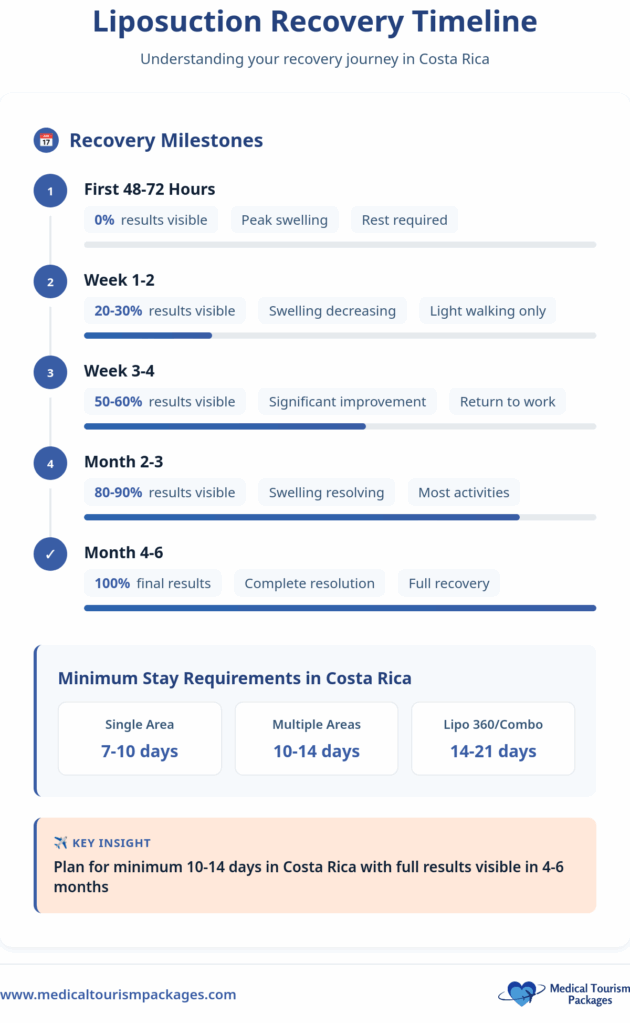
What are the Risks and Potential Complications?
Overall complication rates remain less than 1% when liposuction is performed by board-certified surgeons in accredited facilities. For related body contouring procedures such as gluteoplasty, high-volume centers report overall complication rates of 6.2%. Proper facility selection is critical for your safety since accredited hospitals maintain protocols that minimize risks and respond effectively to any complications that arise.
| Complication Type | Frequency Rate | Severity Level | Treatment Required |
|---|---|---|---|
| Overall complications | <1% | Variable | Depends on issue |
| Hematomas | 0.78% | Moderate | Drainage |
| Contour irregularities | 0.25% | Mild-moderate | May need revision |
| Seroma formation | 0.15% | Mild | Drainage |
| Infections | 0.06% | Mild-severe | Antibiotics |
| Blood clots (DVT/PE) | 0.05% | Severe | Hospitalization |
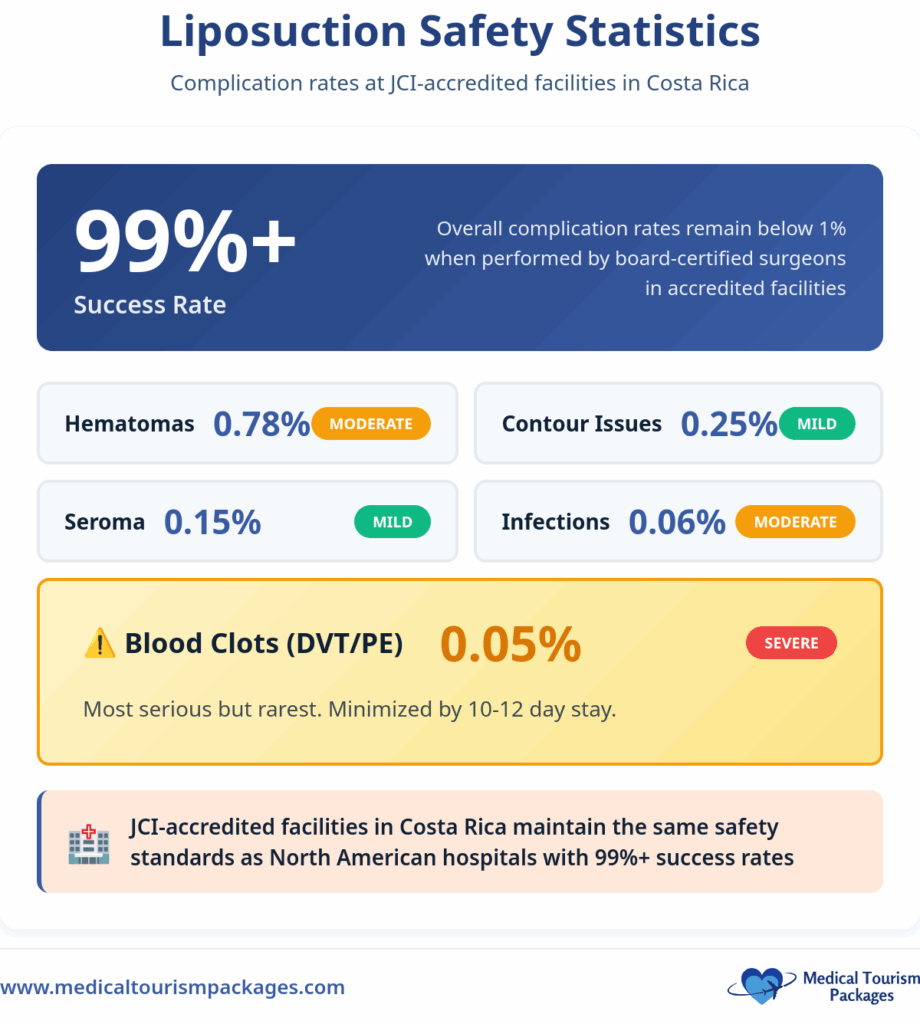
Certain factors increase your risk of complications during and after liposuction:
- Medical conditions: Diabetes or heart disease elevate surgical risks and affect healing
- Smoking: Tobacco use significantly increases infection rates and healing complications
- Multiple procedures: Combining procedures simultaneously increases overall risk per CDC guidelines. Operations lasting over 6 hours dramatically increase the risk of severe infections and postoperative complications
- Large volume removal: Exceeding safe limits beyond five liters of fat removal increases serious complication risks
How Do You Plan Your Medical Trip to Costa Rica?
Planning your medical trip involves selecting the right travel dates and understanding entry requirements for Costa Rica. Timing your surgery during favorable weather conditions improves your recovery experience.
When is the Best Time to Schedule Surgery in Costa Rica?
The dry season from December to April offers consistently sunny weather with minimal rainfall, providing the best conditions for recovery with lower humidity and comfortable compression garment wear. The green season from May to August and November brings short afternoon showers but maintains good, manageable recovery conditions. Avoid the rainy season from September to October, which brings consistent heavy rainfall, high humidity, and limited outdoor mobility.
What Are the Travel Requirements for Costa Rica?
Costa Rica offers straightforward entry requirements for medical tourists:
- Visa-free entry: US, Canada, and most European countries require no visa for stays up to 180 days
- Extended stay allowance: The 180-day permission provides ample time for consultation, procedure, and complete recovery
- Valid passport: Ensure your passport remains valid for at least six months beyond your travel dates
- US dollar usage: Costa Rica accepts US dollars alongside the local colón, eliminating exchange rate concerns
- Travel companion: Bringing a companion provides valuable recovery support and requires the same entry requirements
For comprehensive information about traveling to Costa Rica for medical procedures, see our complete guide for American medical tourists in Costa Rica.
Can You Combine Liposuction with Other Procedures?
Liposuction frequently combines with other cosmetic procedures to achieve comprehensive body transformation. Common combinations include the Mommy Makeover, which pairs tummy tuck, liposuction, and breast procedures to address post-pregnancy changes. The Brazilian Butt Lift uses fat harvested through liposuction to enhance buttock volume and shape. Surgeons also transfer liposuction-harvested fat to the face, breasts, or hands for natural augmentation.
However, the CDC warns about the dangers of performing multiple simultaneous procedures. Combining surgeries increases anesthesia risks, surgical trauma, blood loss, and infection rates. Qualified surgeons follow international safety guidelines and may refuse unsafe combinations that compromise patient safety. Operating time is typically limited to four to six hours, and fat removal cannot exceed five liters per session. Your surgeon will evaluate your specific case to determine which combination procedures meet safety standards for your health profile.
What Results Can You Expect from Liposuction?
Liposuction results develop gradually as swelling subsides over several months following your procedure.
| Time Period | Results Visible | Swelling Status |
|---|---|---|
| First 48-72 hours | 0% | Peak swelling |
| Week 1-2 | 20-30% | Decreasing |
| Week 3-4 | 50-60% | Significant improvement |
| Month 2-3 | 80-90% | Resolving |
| Month 4-6 | 100% | Final results visible |
Liposuction provides permanent fat reduction because surgeons physically remove fat cells that cannot regenerate. Results remain stable for decades when you maintain your weight within 10 to 15 pounds of your post-surgery weight. Moderate weight gain of five to 10 pounds means treated areas remain proportionally smaller than they were before surgery. However, significant weight gain of 15 pounds or more can compromise your results as remaining fat cells expand. Weight loss after liposuction further enhances your contours. Studies show patients preserve 85% of their improvements even five years after surgery when maintaining stable weight.
Start Your Liposuction Journey in Costa Rica
Ready to transform your body with liposuction in Costa Rica? Medical Tourism Packages connects you with board-certified surgeons at JCI-accredited facilities while saving 50-70% compared to US prices. We handle every detail—from surgeon verification and travel coordination to recovery accommodations—so you can focus on your transformation. Schedule your free consultation today to discuss your goals, receive a personalized quote, and learn how we can make your medical journey safe, affordable, and stress-free.
Frequently Asked Questions About Liposuction in Costa Rica
How much does liposuction cost in Costa Rica?
Liposuction in Costa Rica ranges from $1,500 to $7,500 based on the number of areas and technique. Single areas (e.g., arms or hips) start around $1,500, while Lipo 360 typically costs $4,500–$7,500—about 50–70% less than common U.S. prices ($4,711–$12,000+).
Are Costa Rican surgeons qualified to perform liposuction?
Yes. Leading surgeons are board-certified, licensed by the Costa Rican College of Doctors and Surgeons, and often trained at renowned institutions (e.g., Cornell, Baylor). They operate in JCI-accredited hospitals such as CIMA San José, Clínica Bíblica, and Hospital La Católica.
What’s included in a liposuction package in Costa Rica?
Packages usually cover the surgeon’s fee, facility costs, anesthesia, and limited immediate aftercare. Budget separately for flights, lodging, medical tourism insurance, pre-op tests, and post-op medications. Recovery retreats with lymphatic drainage are optional but recommended.
How long should I stay in Costa Rica after liposuction?
Plan 7–10 days for a single area with flight clearance at 10–12 days. Multiple areas usually need 10–14 days, and Lipo 360 or combo surgeries require 14–21 days. Airlines and surgeons generally recommend waiting at least 10–12 days before flying to reduce clot risk.
Is it safe to get liposuction in Costa Rica?
When performed by board-certified surgeons in JCI-accredited facilities, liposuction is considered safe, with complication rates reported below 1% at accredited hospitals. Purchase medical tourism insurance, as standard policies rarely cover elective care abroad, and legal recourse can be limited across jurisdictions.
Can I combine liposuction with other procedures?
Yes. It’s commonly combined with tummy tucks (Mommy Makeover), BBLs, or breast surgery. However, combining procedures increases anesthesia and infection risks. Responsible surgeons cap operating time at ~4–6 hours and limit fat removal to about 5 liters per session for safety.
When will I see my final liposuction results?
Expect early changes at 2–3 weeks (about 20–30% visible). By weeks 3–4, you’ll see roughly 50–60%. Most improvement appears at months 2–3 (80–90%), with final results around 6 months once swelling resolves. Results last if you maintain weight within 10–15 lb of your post-op weight.
Do I need a visa to travel to Costa Rica for liposuction?
Travelers from the U.S., Canada, and most of Europe typically don’t need a visa for stays up to 180 days. Bring a valid passport (ideally with 6 months’ validity), proof of funds, a return ticket, and a clinic appointment letter.
What payment methods are accepted in Costa Rica?
The U.S. dollar is widely used alongside the Costa Rican colón. Most clinics require full payment before or at surgery; some offer payment plans. You can pay via savings, credit cards (mind international fees), personal loans, or third-party medical tourism financing.
What is the best time of year for liposuction in Costa Rica?
The dry season (December–April) offers sunny, low-humidity conditions ideal for recovery and compression wear. The green season (May–August and November) is manageable with brief afternoon showers. Avoid September–October’s heavy rains and higher humidity when mobility can be limited.

